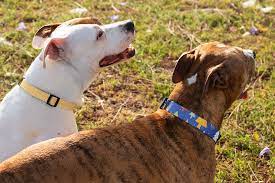Dog collars are a type of accessory that has been around for centuries, mainly used to keep dogs under control while out in public spaces. In recent years, dog collars have evolved into more than just a tool for controlling behavior and have become an essential accessory for pet owners who want to keep their furry friends safe and comfortable. From traditional designs to the latest in technological advancements such as the Halo Collar, there are countless options available to ensure your dog’s well-being and training needs are met. In this article, we’ll take a closer look at why you should use dog collars and the numerous benefits they offer.
Benefits of Using Dog Collars
One of the primary benefits of using a dog collar is identification. It is essential to have a collar with your contact information and your pet’s name to ensure their safe return home if they get lost, especially for toy breeds that are more prone to wandering. Additionally, collars such as the Halo Collar use GPS technology to act as a safety device to prevent dogs from straying into dangerous areas.

Types of Dog Collars
Dog collars serve as an essential accessory for our furry friends, providing identification, control, and comfort. With a wide variety of dog collars available on the market, it can be overwhelming to decide which one is suitable for your pet. In this article, we will discuss the different types of dog collars, from traditional collars to the advanced Halo Cocollarsith GPS technology.
Traditional Collar (Flat or Adjustable)
A traditional collar consists of a flat strip of material, usually made of nylon or leather, that is secured around the dog’s neck with a buckle or clip. The size of the collar can be adjusted to fit snugly around the dog’s neck and it typically has a metal ring to which a leash can be attached.
One of the main benefits of using a traditional collar is that it provides a way to identify your dog by adding a tag with identifying information such as the owner’s name and phone number. Additionally, a traditional collar can help to control unwanted behaviors such as jumping or pulling on the leash.
Martingale Collar
When it comes to dog collars, there are a multitude of options available. One alternative to the traditional collar that has become increasingly popular in recent years is the Martingale Collar. This collar is designed to gently tighten around the dog’s neck when pulling, providing a form of correction that is safer and less harsh than other aversive collars.
Unlike traditional collars, the Martingale Collar has an extra loop of material that tightens when the dog pulls on the leash. This design helps prevent the dog from slipping out of the collar, while also providing a gentle correction that can discourage unwanted behaviors such as pulling or lunging.
Pinch/Prong Collar
Pinch or prong collars are a type of training collar that is designed to control a dog’s behavior by having inward-pointing prongs that pinch the dog’s neck when tightened. They are often used in training to help discourage unwanted behaviors such as excessive pulling on the leash by providing a painful correction.
While some trainers swear by their effectiveness, others argue that pinch collars can cause physical harm to the dog and increase the risk of neck injuries. It’s important to exercise caution when using this type of collar and to only use it under the guidance of a professional trainer who understands how to properly use it.
Choke Chain Collar
A choke chain collar is a type of dog collar that tightens around the dog’s neck when pulled, serving as a reminder to the dog to respond to commands. This collar has been used as a training tool for many years and is commonly used for obedience training and behavior control.
The design of a choke chain collar includes a tightening mechanism that allows the collar to close around the dog’s neck when pulled. This can put pressure on the dog’s trachea and can potentially cause harm if not used correctly. It’s important to exercise caution when using this type of collar and to only use it under the guidance of a professional trainer who understands how to properly use it.
Head Halter/Headcollar
If you’re looking for a humane and effective way to prevent pulling and jumping while walking your dog, the Head Halter/Headcollar training collar is a great option to consider. This collar fits snugly over your dog’s snout and head and has two loops, one that goes over the nose and the other that goes behind the ears.
When your dog pulls, the Halter will pull their head down, discouraging this unwanted behavior. This design ensures that your dog doesn’t experience any discomfort or choking, unlike traditional collars that put pressure on their necks.
Nylon or Leather Collars
When it comes to choosing a dog collar, there are numerous options available in the market. Two of the most popular materials used for dog collars are nylon and leather. Both materials have their unique benefits and drawbacks, and it’s important to understand them before making a decision.
Nylon collars are a popular choice among pet owners due to their lightweight and durable nature. They are also available in a wide variety of colors and designs, making it easy for pet owners to find the perfect collar to suit their dog’s personality. However, nylon collars may not be the best option for dogs with skin sensitivities as the material can cause irritation and rashes.
Breakaway or Safety Collar
As a responsible dog owner, the safety and well-being of your furry friend should always be a top priority. One of the ways to safeguard your dog from harm is by investing in a breakaway or safety collar. This specially designed collar is meant to prevent potential choking or suffocation that may occur as a result of accidental snags or entrapments.
The importance of a breakaway collar can never be overstated as it has the potential to save your dog’s life. A breakaway collar works by releasing its buckle when a certain level of pressure is applied, which reduces the risk of the collar getting caught on fences, branches, or any other objects that could create a choking hazard for your pet. This clever mechanism ensures that your dog can free themselves and avoid suffocation, which would be impossible with a regular collar that doesn’t break away.
No-Pull Harnesses
No-pull harnesses have become increasingly popular among dog owners as a valuable tool for walking their dogs without the constant pulling and tugging on the leash. These types of harnesses offer several benefits over traditional collars and leashes as they are designed to reduce pulling, making it easier for owners to control their dogs.
There are several options available when choosing a no-pull harness for your dog, and it’s important to select the right one based on their size, breed, and walking habits. Front-clip harnesses are an excellent option for dogs that tend to pull when walking as they redirect the dog’s attention toward the owner. These harnesses work by attaching the leash to a ring situated on the front of the dog’s chest, effectively pulling the dog towards the owner when they attempt to pull away.
Factors to Consider When Choosing a Dog Collar
Choosing the right dog collar is an important task for pet owners. With so many options available on the market, it can be overwhelming to make the best decision for your furry friend. Whether you’re looking for a basic collar or a high-tech device like the Halo Collar, there are a few factors to keep in mind to ensure your dog is comfortable, safe, and secure. In this article, we’ll explore the key factors to consider when choosing a dog collar.

Size and Comfortability of the Collar for your dog
As a pet owner, choosing the appropriate size and comfortable collar for your beloved dog is of utmost importance. It not only ensures their safety but also contributes to their behavior and training progress.
Comfortability is crucial for your dog’s behavior and training progress. A collar that is too tight or uncomfortable can result in unwanted behavior, such as excessive barking or refusal to walk on a leash. It’s recommended to select a comfortable collar to provide your furry friend with optimal training experience.
The HALO collar, for instance, is designed with comfort in mind. It uses innovative technology and premium materials to create a collar that is comfortable and safe for your furry friend. The HALO collar is adjustable and customizable, allowing it to fit dogs of different sizes and neck shapes comfortably.
Variety of collar types available for different breeds (Brachycephalic, etc.)
When it comes to selecting a collar for your furry friend, it’s essential to consider the unique needs of the breed, especially for Brachycephalic breeds. Brachycephalic breeds, or breeds with short snouts and flat faces, often face respiratory issues, making it crucial to choose a collar that will not put unnecessary pressure on their neck or respiratory system.
The variety of collar types available ensures that every breed can have a collar that suits their unique needs. Some popular collar types for Brachycephalic breeds include flat collars, martingale collars, and no-pull harnesses.
When selecting a collar for a Brachycephalic breed, it is important to choose a collar that does not put pressure on the dog’s neck or respiratory system. Collars made of soft materials, such as nylon, neoprene, or padded leather, are ideal. Avoid collars made of heavy chains, prong collars, or choke chains as they put pressure on the neck and can cause injury or discomfort.
The Training Tool You Need For Your Pet
As a pet owner, it can be challenging to train your furry friend to behave appropriately in various situations. Fortunately, several types of collars are designed specifically for training purposes, which can make things a little easier. In this article, we will introduce you to different types of training collars, their functions, safety considerations, and situations where they may be effective.
The Halo Collar is a popular new product that combines GPS tracking, training technology, and smart features. It offers a virtual fence that sends an alert on your phone if it detects that the pet is attempting to cross the boundary.
Positive training methods, such as clickers and target sticks, can be effective in teaching new behaviors and commands to your pet. These products reinforce positive behaviors and provide immediate feedback to the pet, rather than punishing negative behavior. They also strengthen the bond between the owner and pet and may be used without the risk of injury to pets.
Conclusion
In conclusion, dog collars are essential for the safety and better control of your pet, especially during training. There are various types of collars available, including flat collars, martingale collars, and the innovative Halo Collar, which offers GPS tracking and training technology. Each collar has its benefits for specific breeds and training methods, providing adequate control while ensuring your pet’s comfort.
